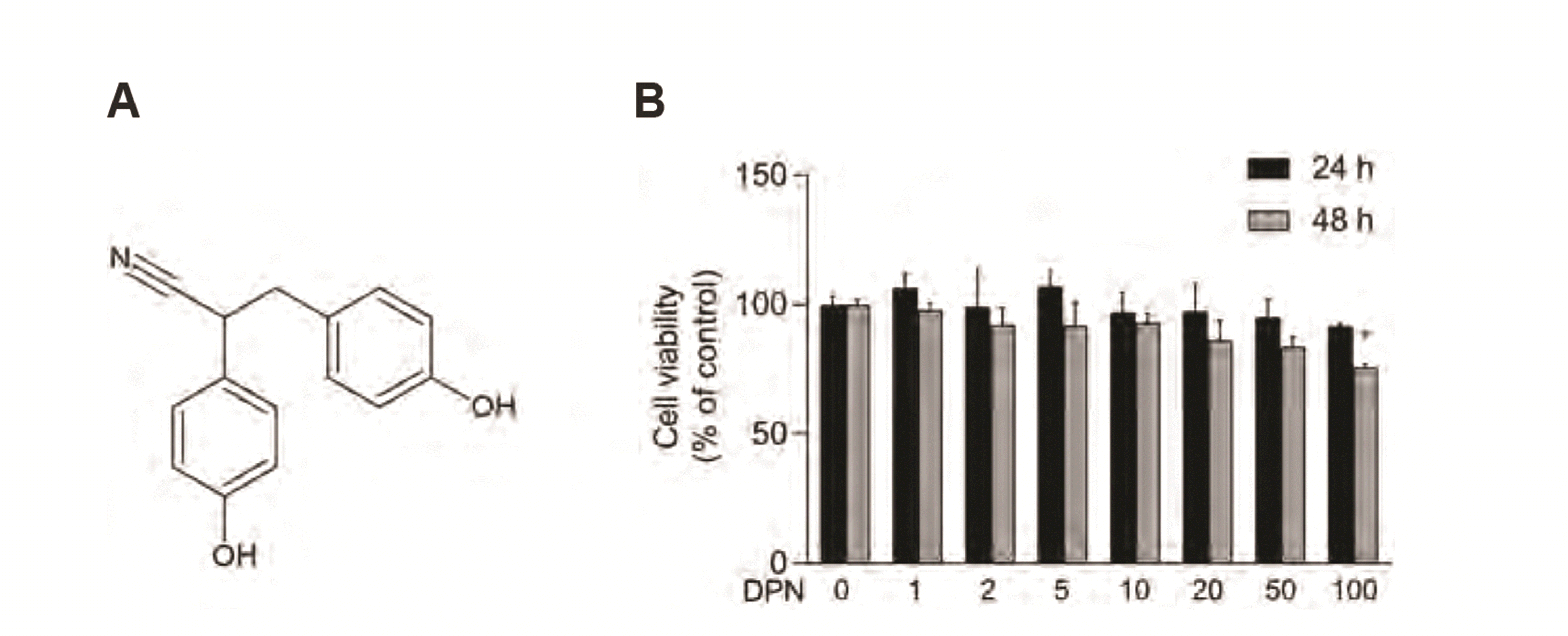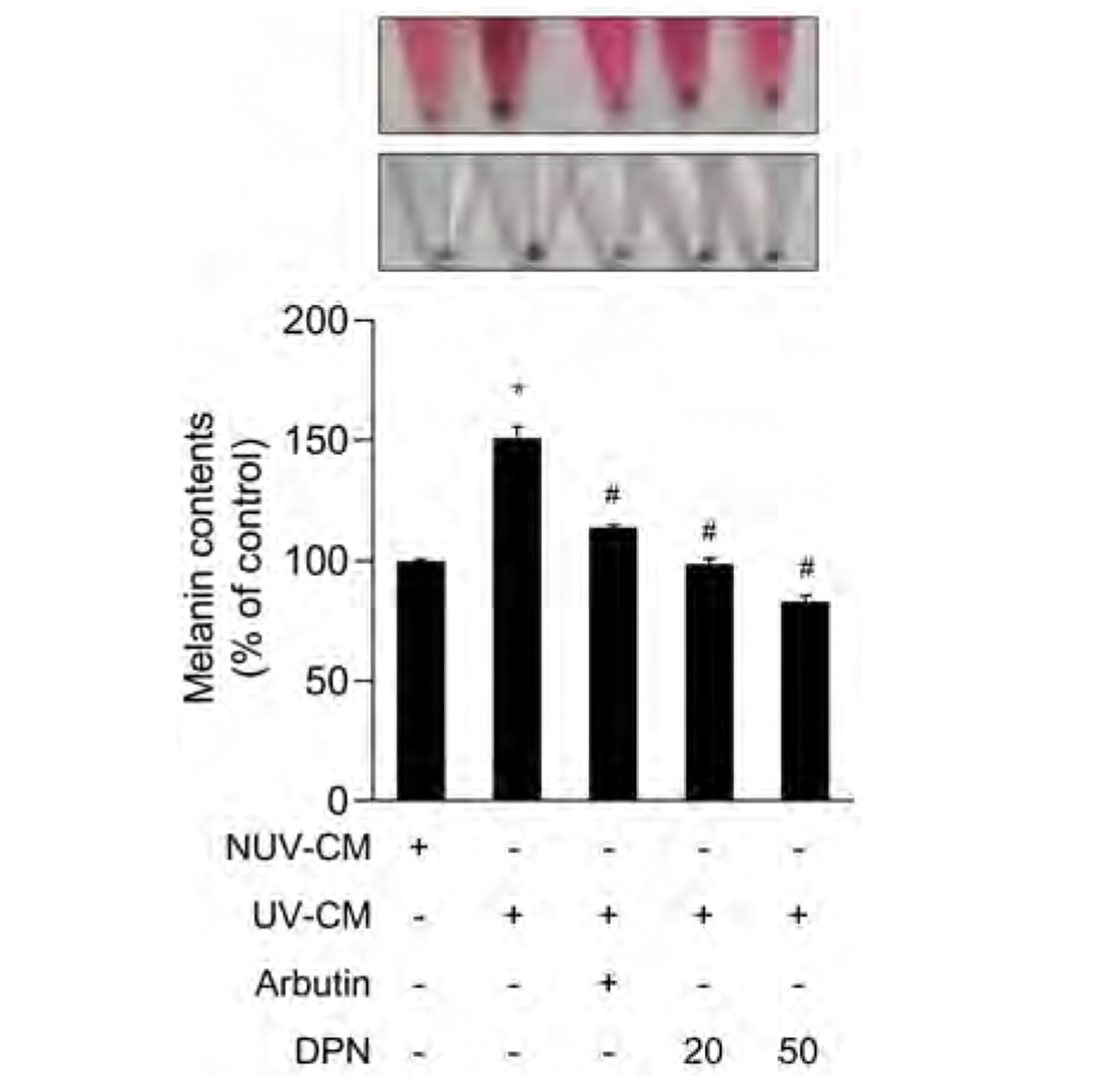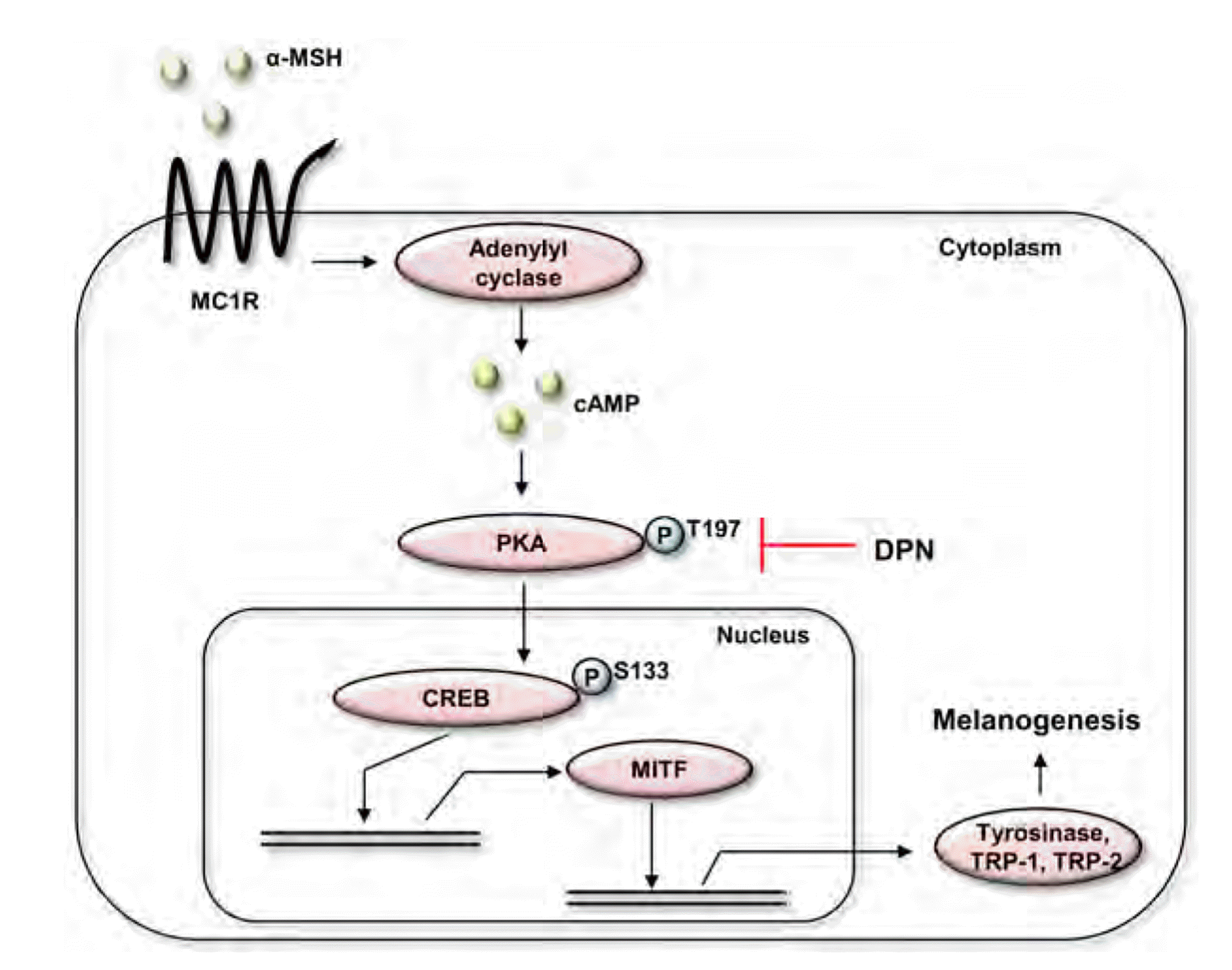1. Meyers MJ, Sun J, Carlson KE, Marriner GA, Katzenellenbogen BS, Katzenellenbogen JA. 2001; Estrogen receptor-beta potency-selective ligands: structure-activity relationship studies of diarylpropionitriles and their acetylene and polar analogues. J Med Chem. 44:4230–4251. DOI:
10.1021/jm010254a. PMID:
11708925.

2. Walf AA, Koonce CJ, Frye CA. 2008; Estradiol or diarylpropionitrile administration to wild type, but not estrogen receptor beta knockout, mice enhances performance in the object recognition and object placement tasks. Neurobiol Learn Mem. 89:513–521. DOI:
10.1016/j.nlm.2008.01.008. PMID:
18313947. PMCID:
PMC2424257.

3. Motylewska E, Stasikowska O, Mełeń-Mucha G. 2009; The inhibitory effect of diarylpropionitrile, a selective agonist of estrogen receptor beta, on the growth of MC38 colon cancer line. Cancer Lett. 276:68–73. DOI:
10.1016/j.canlet.2008.10.050. PMID:
19101081.

4. Huang SY, Xin H, Sun J, Li R, Zhang XM, Zhao D. 2013; Estrogen receptor β agonist diarylpropionitrile inhibits lipopolysaccharide-induced regulated on activation normal T cell expressed and secreted (RANTES) production in macrophages by repressing nuclear factor κB activation. Fertil Steril. 100:234–240. DOI:
10.1016/j.fertnstert.2013.02.052. PMID:
23557759.

5. Weiser MJ, Wu TJ, Handa RJ. 2009; Estrogen receptor-beta agonist diarylpropionitrile: biological activities of R- and S-enantiomers on behavior and hormonal response to stress. Endocrinology. 150:1817–1825. DOI:
10.1210/en.2008-1355. PMID:
19074580. PMCID:
PMC2659273.

6. Mancuso M, Leonardi S, Giardullo P, Pasquali E, Borra F, Stefano ID, Prisco MG, Tanori M, Scambia G, Majo VD, Pazzaglia S, Saran A, Gallo D. 2011; The estrogen receptor beta agonist diarylpropionitrile (DPN) inhibits medulloblastoma development via anti-proliferative and pro-apototic pathways. Cancer Lett. 308:197–202. DOI:
10.1016/j.canlet.2011.05.004. PMID:
21636213.

7. Michel T, Halabalaki M, Skaltsounis AL. 2013; New concepts, experimental approaches, and dereplication strategies for the discovery of novel phytoestrogens from natural sources. Planta Med. 79:514–532. DOI:
10.1055/s-0032-1328300. PMID:
23479392.

8. Yang J, Wen L, Jiang Y, Yang B. 2019; Natural estrogen receptor modulators and their heterologous biosynthesis. Trends Endocrinol Metab. 30:66–76. DOI:
10.1016/j.tem.2018.11.002. PMID:
30527917.

9. Pillaiyar T, Namasivayam V, Manickam M, Jung SH. 2018; Inhibitors of melanogenesis: an updated review. J Med Chem. 61:7395–7418. DOI:
10.1021/acs.jmedchem.7b00967. PMID:
29763564.

11. Vachtenheim J, Borovanský J. 2010; "Transcription physiology" of pigment formation in melanocytes: central role of MITF. Exp Dermatol. 19:617–627. DOI:
10.1111/j.1600-0625.2009.01053.x. PMID:
20201954.

12. Tsukamoto K, Jackson IJ, Urabe K, Montague PM, Hearing VJ. 1992; A second tyrosinase-related protein, TRP-2, is a melanogenic enzyme termed DOPAchrome tautomerase. EMBO J. 11:519–526. DOI:
10.1002/j.1460-2075.1992.tb05082.x. PMID:
1537333. PMCID:
PMC556482.

13. Kobayashi T, Urabe K, Winder A, Jiménez-Cervantes C, Imokawa G, Brewington T, Solano F, García-Borrón JC, Hearing VJ. 1994; Tyrosinase related protein 1 (TRP1) functions as a DHICA oxidase in melanin biosynthesis. EMBO J. 13:5818–5825. DOI:
10.1002/j.1460-2075.1994.tb06925.x. PMID:
7813420. PMCID:
PMC395555.

14. Chen T, Zhao B, Liu Y, Wang R, Yang Y, Yang L, Dong C. 2018; MITF-M regulates melanogenesis in mouse melanocytes. J Dermatol Sci. 90:253–262. DOI:
10.1016/j.jdermsci.2018.02.008. PMID:
29496358.

15. Du J, Miller AJ, Widlund HR, Horstmann MA, Ramaswamy S, Fisher DE. 2003; MLANA/MART1 and SILV/PMEL17/GP100 are transcriptionally regulated by MITF in melanocytes and melanoma. Am J Pathol. 163:333–343. DOI:
10.1016/S0002-9440(10)63657-7. PMID:
12819038. PMCID:
PMC1868174.

16. Aoki H, Moro O. 2002; Involvement of microphthalmia-associated transcription factor (MITF) in expression of human melanocortin-1 receptor (MC1R). Life Sci. 71:2171–2179. DOI:
10.1016/S0024-3205(02)01996-3. PMID:
12204775.

17. Tagashira H, Miyamoto A, Kitamura S, Tsubata M, Yamaguchi K, Takagaki K, Imokawa G. 2015; UVB stimulates the expression of endothelin B receptor in human melanocytes via a sequential activation of the p38/MSK1/CREB/MITF pathway which can be interrupted by a French maritime pine bark extract through a direct inactivation of MSK1. PLoS One. 10:e0128678. DOI:
10.1371/journal.pone.0128678. PMID:
26030901. PMCID:
PMC4452497.

19. Yamaguchi Y, Coelho SG, Zmudzka BZ, Takahashi K, Beer JZ, Hearing VJ, Miller SA. 2008; Cyclobutane pyrimidine dimer formation and p53 production in human skin after repeated UV irradiation. Exp Dermatol. 17:916–924. DOI:
10.1111/j.1600-0625.2008.00722.x. PMID:
18363705.

20. Cui R, Widlund HR, Feige E, Lin JY, Wilensky DL, Igras VE, D'Orazio J, Fung CY, Schanbacher CF, Granter SR, Fisher DE. 2007; Central role of p53 in the suntan response and pathologic hyperpigmentation. Cell. 128:853–864. DOI:
10.1016/j.cell.2006.12.045. PMID:
17350573.

21. Yamamoto H, Yamane T, Iguchi K, Tanaka K, Iddamalgoda A, Unno K, Hoshino M, Takeda A. 2015; Melanin production through novel processing of proopiomelanocortin in the extracellular compartment of the auricular skin of C57BL/6 mice after UV-irradiation. Sci Rep. 5:14579. DOI:
10.1038/srep14579. PMID:
26417724. PMCID:
PMC4586518.

22. Neary CL, Cho-Chung YS. 2001; Nuclear translocation of the catalytic subunit of protein kinase A induced by an antisense oligonucleotide directed against the RIalpha regulatory subunit. Oncogene. 20:8019–8024. DOI:
10.1038/sj.onc.1204992. PMID:
11753685.

23. Yun CY, You ST, Kim JH, Chung JH, Han SB, Shin EY, Kim EG. 2015; p21-activated kinase 4 critically regulates melanogenesis via activation of the CREB/MITF and β-catenin/MITF pathways. J Invest Dermatol. 135:1385–1394. DOI:
10.1038/jid.2014.548. PMID:
25560280.

26. Smalley K, Eisen T. 2000; The involvement of p38 mitogen-activated protein kinase in the alpha-melanocyte stimulating hormone (alpha-MSH)-induced melanogenic and anti-proliferative effects in B16 murine melanoma cells. FEBS Lett. 476:198–202. DOI:
10.1016/S0014-5793(00)01726-9. PMID:
10913613.

27. Bae IH, Lee ES, Yoo JW, Lee SH, Ko JY, Kim YJ, Lee TR, Kim DY, Lee CS. 2019; Mannosylerythritol lipids inhibit melanogenesis via suppressing ERK-CREB-MiTF-tyrosinase signalling in normal human melanocytes and a three-dimensional human skin equivalent. Exp Dermatol. 28:738–741. DOI:
10.1111/exd.13836. PMID:
30408247.

29. Marzagalli M, Casati L, Moretti RM, Montagnani Marelli M, Limonta P. 2015; Estrogen receptor β agonists differentially affect the growth of human melanoma cell lines. PLoS One. 10:e0134396. DOI:
10.1371/journal.pone.0134396. PMID:
26225426. PMCID:
PMC4520550.

30. Marzagalli M, Montagnani Marelli M, Casati L, Fontana F, Moretti RM, Limonta P. 2016; Estrogen receptor β in melanoma: from molecular insights to potential clinical utility. Front Endocrinol (Lausanne). 7:140. DOI:
10.3389/fendo.2016.00140. PMID:
27833586. PMCID:
PMC5080294.

31. Levy C, Khaled M, Fisher DE. 2006; MITF: master regulator of melanocyte development and melanoma oncogene. Trends Mol Med. 12:406–414. DOI:
10.1016/j.molmed.2006.07.008. PMID:
16899407.

32. Niwano T, Terazawa S, Nakajima H, Imokawa G. 2018; The stem cell factor-stimulated melanogenesis in human melanocytes can be abrogated by interrupting the phosphorylation of MSK1: evidence for involvement of the p38/MSK1/CREB/MITF axis. Arch Dermatol Res. 310:187–196. DOI:
10.1007/s00403-018-1816-x. PMID:
29362867.

33. Cheng X, Ma Y, Moore M, Hemmings BA, Taylor SS. 1998; Phosphorylation and activation of cAMP-dependent protein kinase by phosphoinositide-dependent protein kinase. Proc Natl Acad Sci U S A. 95:9849–9854. DOI:
10.1073/pnas.95.17.9849. PMID:
9707564. PMCID:
PMC21425.

34. Saha B, Singh SK, Sarkar C, Bera R, Ratha J, Tobin DJ, Bhadra R. 2006; Activation of the Mitf promoter by lipid-stimulated activation of p38-stress signalling to CREB. Pigment Cell Res. 19:595–605. DOI:
10.1111/j.1600-0749.2006.00348.x. PMID:
17083486.

35. Yuan XH, Jin ZH. 2018; Paracrine regulation of melanogenesis. Br J Dermatol. 178:632–639. DOI:
10.1111/bjd.15651. PMID:
28494100.

36. Lei MJ, Dong Y, Sun CX, Zhang XH. 2017; Resveratrol inhibits proliferation, promotes differentiation and melanogenesis in HT-144 melanoma cells through inhibition of MEK/ERK kinase pathway. Microb Pathog. 111:410–413. DOI:
10.1016/j.micpath.2017.09.029. PMID:
28919486.

37. Park J, Park JH, Suh HJ, Lee IC, Koh J, Boo YC. 2014; Effects of resveratrol, oxyresveratrol, and their acetylated derivatives on cellular melanogenesis. Arch Dermatol Res. 306:475–487. DOI:
10.1007/s00403-014-1440-3. PMID:
24414332.

38. Lee YS, Kim HK, Lee KJ, Jeon HW, Cui S, Lee YM, Moon BJ, Kim YH, Lee YS. 2010; Inhibitory effect of glyceollin isolated from soybean against melanogenesis in B16 melanoma cells. BMB Rep. 43:461–467. DOI:
10.5483/BMBRep.2010.43.7.461. PMID:
20663406.

39. Shin SH, Lee YM. 2013; Glyceollins, a novel class of soybean phytoalexins, inhibit SCF-induced melanogenesis through attenuation of SCF/c-kit downstream signaling pathways. Exp Mol Med. 45:e17. DOI:
10.1038/emm.2013.20. PMID:
23559126. PMCID:
PMC3641398.

40. Lee AY, Noh M. 2013; The regulation of epidermal melanogenesis via cAMP and/or PKC signaling pathways: insights for the development of hypopigmenting agents. Arch Pharm Res. 36:792–801. DOI:
10.1007/s12272-013-0130-6. PMID:
23604723.

41. Bae-Harboe YS, Park HY. 2012; Tyrosinase: a central regulatory protein for cutaneous pigmentation. J Invest Dermatol. 132:2678–2680. DOI:
10.1038/jid.2012.324. PMID:
23187110.

42. Fan M, Zhang G, Hu X, Xu X, Gong D. 2017; Quercetin as a tyrosinase inhibitor: inhibitory activity, conformational change and mechanism. Food Res Int. 100(Pt 1):226–233. DOI:
10.1016/j.foodres.2017.07.010. PMID:
28873682.

43. Chen QX, Kubo I. 2002; Kinetics of mushroom tyrosinase inhibition by quercetin. J Agric Food Chem. 50:4108–4112. DOI:
10.1021/jf011378z. PMID:
12083892.

45. Verastegui C, Bertolotto C, Bille K, Abbe P, Ortonne JP, Ballotti R. 2000; TFE3, a transcription factor homologous to Microphthalmia, is a potential transcriptional activator of tyrosinase and TyrpI genes. Mol Endocrinol. 14:449–456. DOI:
10.1210/mend.14.3.0428. PMID:
10707962.

46. Murisier F, Guichard S, Beermann F. 2007; The tyrosinase enhancer is activated by Sox10 and Mitf in mouse melanocytes. Pigment Cell Res. 20:173–184. DOI:
10.1111/j.1600-0749.2007.00368.x. PMID:
17516925.

47. Ando H, Ichihashi M, Hearing VJ. 2009; Role of the ubiquitin proteasome system in regulating skin pigmentation. Int J Mol Sci. 10:4428–4434. DOI:
10.3390/ijms10104428. PMID:
20057953. PMCID:
PMC2790116.

48. Kageyama A, Oka M, Okada T, Nakamura S, Ueyama T, Saito N, Hearing VJ, Ichihashi M, Nishigori C. 2004; Down-regulation of melanogenesis by phospholipase D2 through ubiquitin proteasome-mediated degradation of tyrosinase. J Biol Chem. 279:27774–27780. DOI:
10.1074/jbc.M401786200. PMID:
15067002.

49. Widlund HR, Fisher DE. 2003; Microphthalamia-associated transcription factor: a critical regulator of pigment cell development and survival. Oncogene. 22:3035–3041. DOI:
10.1038/sj.onc.1206443. PMID:
12789278.

50. Fang D, Tsuji Y, Setaluri V. 2002; Selective down-regulation of tyrosinase family gene TYRP1 by inhibition of the activity of melanocyte transcription factor, MITF. Nucleic Acids Res. 30:3096–3106. DOI:
10.1093/nar/gkf424. PMID:
12136092. PMCID:
PMC135745.

51. Ludwig A, Rehberg S, Wegner M. 2004; Melanocyte-specific expression of dopachrome tautomerase is dependent on synergistic gene activation by the Sox10 and Mitf transcription factors. FEBS Lett. 556:236–244. DOI:
10.1016/S0014-5793(03)01446-7. PMID:
14706856.

52. Roh E, Yun CY, Yun JY, Park D, Kim ND, Hwang BY, Jung SH, Park SK, Kim YB, Han SB, Kim Y. 2013; cAMP-binding site of PKA as a molecular target of bisabolangelone against melanocyte-specific hyperpigmented disorder. J Invest Dermatol. 133:1072–1079. DOI:
10.1038/jid.2012.425. PMID:
23254773.

53. Lee HS, Goh MJ, Kim J, Choi TJ, Lee HK, Na YJ, Cho KH. 2015; A systems-biological study on the identification of safe and effective molecular targets for the reduction of ultraviolet B-induced skin pigmentation. Sci Rep. 5:10305. DOI:
10.1038/srep10305. PMID:
25980672. PMCID:
PMC4434836.

54. Buscà R, Abbe P, Mantoux F, Aberdam E, Peyssonnaux C, Eychène A, Ortonne JP, Ballotti R. 2000; Ras mediates the cAMP-dependent activation of extracellular signal-regulated kinases (ERKs) in melanocytes. EMBO J. 19:2900–2910. DOI:
10.1093/emboj/19.12.2900. PMID:
10856235. PMCID:
PMC203360.

55. Ko GA, Cho SK. 2018; Phytol suppresses melanogenesis through proteasomal degradation of MITF via the ROS-ERK signaling pathway. Chem Biol Interact. 286:132–140. DOI:
10.1016/j.cbi.2018.02.033. PMID:
29486182.

56. Wu M, Hemesath TJ, Takemoto CM, Horstmann MA, Wells AG, Price ER, Fisher DZ, Fisher DE. 2000; c-Kit triggers dual phosphorylations, which couple activation and degradation of the essential melanocyte factor Mi. Genes Dev. 14:301–312. DOI:
10.1101/gad.14.3.301. PMID:
10673502. PMCID:
PMC316361.

57. Valero MS, Pereboom D, Barcelo-Batllory S, Brines L, Garay RP, Alda JO. 2011; Protein kinase A signalling is involved in the relaxant responses to the selective β-oestrogen receptor agonist diarylpropionitrile in rat aortic smooth muscle in vitro. J Pharm Pharmacol. 63:222–229. DOI:
10.1111/j.2042-7158.2010.01203.x. PMID:
21235586.

58. Dumaz N, Marais R. 2005; Integrating signals between cAMP and the RAS/RAF/MEK/ERK signalling pathways. Based on the anniversary prize of the Gesellschaft für Biochemie und Molekularbiologie Lecture delivered on 5 July 2003 at the Special FEBS Meeting in Brussels. FEBS J. 272:3491–3504. DOI:
10.1111/j.1742-4658.2005.04763.x. PMID:
16008550.

59. Poletini MO, de Assis LV, Moraes MN, Castrucci AM. 2016; Estradiol differently affects melanin synthesis of malignant and normal melanocytes: a relationship with clock and clock-controlled genes. Mol Cell Biochem. 421:29–39. DOI:
10.1007/s11010-016-2781-3. PMID:
27535239.

61. Dika E, Patrizi A, Lambertini M, Manuelpillai N, Fiorentino M, Altimari A, Ferracin M, Lauriola M, Fabbri E, Campione E, Veronesi G, Scarfì F. 2019; Estrogen receptors and melanoma: a review. Cells. 8:1463. DOI:
10.3390/cells8111463. PMID:
31752344. PMCID:
PMC6912660. PMID:
ccc5d5e6b8ab4e0fa7333651992e1cca.

62. Ranson M, Posen S, Mason RS. 1988; Human melanocytes as a target tissue for hormones: in vitro studies with 1 alpha-25, dihydroxyvitamin D3, alpha-melanocyte stimulating hormone, and beta-estradiol. J Invest Dermatol. 91:593–598. DOI:
10.1111/1523-1747.ep12477126. PMID:
2848074.

63. Sun M, Xie HF, Tang Y, Lin SQ, Li JM, Sun SN, Hu XL, Huang YX, Shi W, Jian D. 2017; G protein-coupled estrogen receptor enhances melanogenesis via cAMP-protein kinase (PKA) by upregulating microphthalmia-related transcription factor-tyrosinase in melanoma. J Steroid Biochem Mol Biol. 165(Pt B):236–246. DOI:
10.1016/j.jsbmb.2016.06.012. PMID:
27378491.

64. Seidlová-Wuttke D, Becker T, Christoffel V, Jarry H, Wuttke W. 2003; Silymarin is a selective estrogen receptor beta (ERbeta) agonist and has estrogenic effects in the metaphysis of the femur but no or antiestrogenic effects in the uterus of ovariectomized (ovx) rats. J Steroid Biochem Mol Biol. 86:179–188. DOI:
10.1016/S0960-0760(03)00270-X. PMID:
14568570.

65. Choo SJ, Ryoo IJ, Kim YH, Xu GH, Kim WG, Kim KH, Moon SJ, Son ED, Bae K, Yoo ID. 2009; Silymarin inhibits melanin synthesis in melanocyte cells. J Pharm Pharmacol. 61:663–667. DOI:
10.1211/jpp.61.05.0016. PMID:
19406006.

66. Rouzaud F, Kadekaro AL, Abdel-Malek ZA, Hearing VJ. 2005; MC1R and the response of melanocytes to ultraviolet radiation. Mutat Res. 571:133–152. DOI:
10.1016/j.mrfmmm.2004.09.014. PMID:
15748644.











 PDF
PDF Citation
Citation Print
Print


 XML Download
XML Download